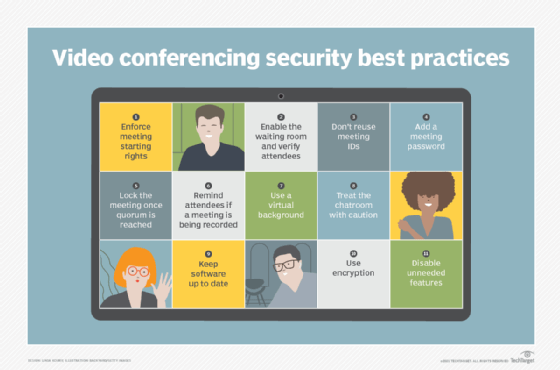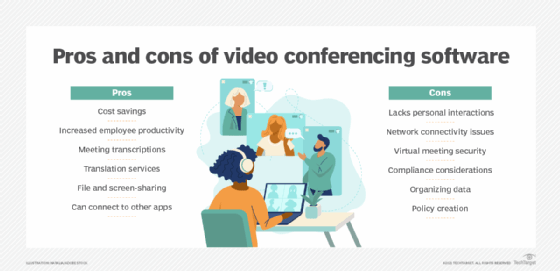What is video conferencing? (original) (raw)
Video conferencing is a live, visual connection between two or more remote parties over the internet that simulates a face-to-face meeting. Video conferencing is important because it joins people who would not normally be able to form a face-to-face connection.
At its simplest, video conferencing involves transmitting static images and text between two locations. At its most sophisticated, it provides transmission of full-motion video images and high-quality audio between multiple locations.
In the business world, desktop video conferencing is a core component of unified communications platforms that also include calling and messaging capabilities. Standalone on-premises and cloud-based video conferencing platforms are also available from numerous vendors who support desktop- and room-based video, as well as the ability to embed video conferencing into business applications, such as Telehealth, customer service and distance learning.
The widespread availability of cloud-based services enables organizations to implement video conferencing with minimal upfront investment and to take advantage of rapidly emerging AI-powered features to improve audio and video performance.
How video conferencing works
The video conferencing process can be split into two steps: compression and transfer.
During compression, the camera and microphone capture analog audiovisual (AV) input. The data collected is in the form of continuous waves of frequencies and amplitudes. These represent the captured sounds, colors, brightness, depth and shades. Once captured, codecs convert data into digital packets, typically with compression to minimize bandwidth usage.
During the transfer phase, packets are sent over the network, typically to the cloud service provider, which then transmits them to other conference call participants (and combines voice and video from multiple participants).
Once packets reach the endpoint, the codecs decompress the data. The codecs convert it back into analog audio and video. This enables the receiving screen and speakers to correctly view and hear the AV data.
Components of video conferencing systems
The components of a video conferencing system include the following:
- A network for data transfer, such as wired/wireless local area network (LAN), wide area network (WAN), cellular wireless and residential broadband.
- Two or more video cameras or webcams that provide video input.
- Two or more microphones -- either an external microphone or one built into the accessing device.
- A computer screen, monitor, TV or projector that can broadcast video output.
- Headphones, laptop speakers or external speakers that can be used for audio output.
- Codecs, which can be hardware- or software-based, to reduce bandwidth by compressing and decompressing AV data. They typically include acoustic echo cancellation capabilities, which reduce audio delays to support real-time communication. Codecs might also include features like noise cancellation and acoustic fencing to minimize background noise during conferences.
Benefits of video conferencing
Video conferencing services carry many benefits. In businesses, they can increase productivity among employees, as well as provide an improved way of communicating and interacting with colleagues, partners and customers.
For small businesses and enterprises, the tangible benefits of video conferencing include lower travel costs -- especially, for employee training -- and shortened meeting and project times as a result of improved communications among team members. Businesses can also increase revenue through higher quality virtual sales meetings.
The intangible benefits of video conferencing include more efficient meetings with the exchange of nonverbal communications and a stronger sense of community among business contacts, both within and between companies, as well as with customers.
On a personal level, the face-to-face connection enables participants to develop a stronger sense of familiarity with individuals they might never actually meet in person. In the aftermath of the COVID-19 pandemic, many companies use video conferencing for community-building activities and social gatherings, including lunch and learns, health and wellness activities, happy hours and games.
Disadvantages of video conferencing
While video conferencing provides numerous benefits for businesses and individuals, it also has several disadvantages. For example, high-quality video calling and conferencing demand a consistently reliable high-speed internet connection with minimal latency and jitter. Only a strong internet connection can guarantee the voice audio and visuals will be reliably and smoothly communicated.
Any issues with bandwidth or internet connectivity could cause the audio and/or video displays to be interrupted or lost, so quality of service measures might be required for important calls.
Another disadvantage is the cost of high-quality video conferencing systems. While many companies adopt video conferencing services to reduce business travel costs, they will still end up spending large amounts of money on a video conferencing system, especially for larger offices.
In addition to all the costly equipment and technology, companies will often also need to pay for the installation, deployment and maintenance of endpoints and on-premises servers if using an on-premises platform.

Video conferencing security best practices are critical to securing user credentials, network access and business data.
Finally, companies are advised to adhere to video conferencing security best practices to safeguard network access, user attendance and business data.
History of video conferencing
The first developments in video conferencing can be traced back to the 1920s, when AT&T Bell Labs and John Logie Baird started experimenting with video phones.
In the 1930s, early video conferencing experiments were also conducted in Germany. This early technology included image phones that would send still pictures over phone lines.
In the early 1970s, AT&T started using video conferencing with its Picturephone service. This was essentially a dial-up service arrangement that required large cables connecting the network access point to the physical Picturephone device. As this arrangement was both costly and inconvenient, AT&T launched Picturephone Meeting Service (PMS) in the mid-1970s to provide fee-based video conferencing. Once a call had been scheduled, users had to travel to a local Picturephone Meeting Center conference room. The service was costly and limited to only those locations where AT&T had a PMS meeting room.
Widespread adoption of video conferencing began in the 1980s with the computer revolution. The revolution brought about the invention of codecs, as well as the rise of broadband services, such as Integrated Services Digital Network (ISDN), enabling the sending of visual images for personal use. The later introduction of mobile phones further facilitated the popularity of video conferencing.
Webcams started appearing on college campuses in the 1990s. In August 1994, the QuickCam -- the first commercial webcam -- was introduced. However, it was only compatible with Mac, so a Windows-compatible version was released in 1995. In 2010, Time magazine named QuickCam one of the top computer devices of all time.
In 1992, Cornell University IT department personnel developed the CU-SeeMe video conferencing software for Mac. They developed the software for Windows in 1994. The CU-SeeMe software was commercially released in 1995; it introduced the first internet radio stations.
In 2004, many businesses started adopting video conferencing systems for the first time because broadband technology was finally more affordable and widespread. Video conferencing adoption grew throughout the 2010s, and rapidly accelerated as the COVID-19 pandemic drove the vast majority of employees out of their offices and into their homes, requiring an improved video meeting experience.
Video conferencing vendors
Consumer services today -- including Apple FaceTime, Google Meet, GoToMeeting, Cisco Webex, Microsoft Teams and Skype -- have made video conferencing ubiquitous on desktops and mobile devices that have an embedded camera.
In the enterprise space, video conferencing platforms include those offering conferencing applications, personal or room-based conferencing endpoints, or both applications and endpoints.
Other video conferencing vendors and their products include the following:
| Adobe Connect | Fuze | Owl Labs |
|---|---|---|
| Amazon Chime | GoToMeeting | Pexip |
| Angekis | Jabra | PGi |
| AudioCodes | Join.me | Poly |
| Avaya | Konftel | RingCentral |
| Class Collaborate | Lifesize | TeamViewer Meeting |
| Dialpad | Logitech | Yealink |
| DTEN | Mitel | Zoom |
| FreeConferenceCall.com | Neat | ZTE |
Video conferencing and remote working
Video conferencing is particularly useful for remote workers, who likely rely on these services to host many of their work-related meetings. As remote workers typically do not make use of companies' traditional office spaces, use of video conferencing can provide simulated face-to-face contact between team members and colleagues. Furthermore, using video conference collaboration tools, such as screen sharing, can make video calls far more useful for employee interaction and collaboration than being limited to voice communications.
Not only can video conferencing provide better communication and productivity, but it can also foster the development of important co-working relationships, as it is more engaging than simply hearing voices over the phone or corresponding via email.
However, the increased use of video in remote work has also led to the rise of video fatigue. Users who are frequently on video meetings can experience symptoms including eye strain, exhaustion and headaches.
The use of video conferencing by remote workers is likely to decline as more organizations bring employees back into their physical offices. Some government and nongovernment entities have migrated to a hybrid work arrangement where employees work remotely one to two days a week and the rest of the time in their offices. However, a trend is emerging to have all employees back in the office full-time, with remote work requiring approval.
One important benefit of remote work -- and video conferencing -- is that it helps facilitate business continuity (and continuity of operations, or COOP) activities in situations where employees cannot occupy their primary work locations.

The advantages and disadvantages of video conferencing software revolve around privacy, cost and content sharing capabilities.
The impact of artificial intelligence on video conferencing
As might be expected, AI is likely to dramatically improve the ease of use for video conferencing and enhance the overall user experience in the following ways:
- Transcription and translation services. Capturing the details of a meeting withtranscription services enhanced by AI can generate a true record of the meeting. And if language translation is needed, AI tools should simplify that process as well.
- Meeting summaries. When properly configured, AI-enhanced meeting summaries can be generated from the above transcription features.
- Scheduling and reminders. AI can automate scheduling of meetings and sending reminders.
- Enhanced presentation aids. The use of AI is expected to improve presentations and audience engagement activities.
- Audience experience quality. AI can help ensure that all conference participants can see and hear each other without extraneous noise or interference.
- Delivery of enhanced content. Based on knowledge of conference delegates and their requirements, AI can tailor content to fit each individual's needs.
- Enhanced analytics . To ensure that current and future meetings are effective, AI can examine and analyze data from previous meetings and use that data to provide guidance on effective meetings.
Companies use video conferencing technologies to maintain business operations for remote offices and workers, as video conferencing provides the closest approximation to an actual, face-to-face meeting. Beyond its use for in-company meetings, video conferencing has been adopted for job candidate interviews in lieu of on-site interviews.
Zoom, a widely popular video conference service provider, experienced explosive growth during the pandemic, as did Microsoft Teams.
As a post-pandemic workplace takes shape, with many employees returning to the office, video conferencing will continue to be an important method of remote communication. Video conferencing providers continue to enhance their offerings to create an equitable experience for remote and in-office participants. Today, Zoom, Microsoft Teams and Skype, Google Meet, GoToMeeting, and Cisco Webex are the most widely used video conference services. (Microsoft will be retiring Skype in May 2025.)
Video conferencing can save businesses money and improve employee productivity, but it can hinder personal connections, and it requires more secure technology. Explore a video conferencing advantages and disadvantages.